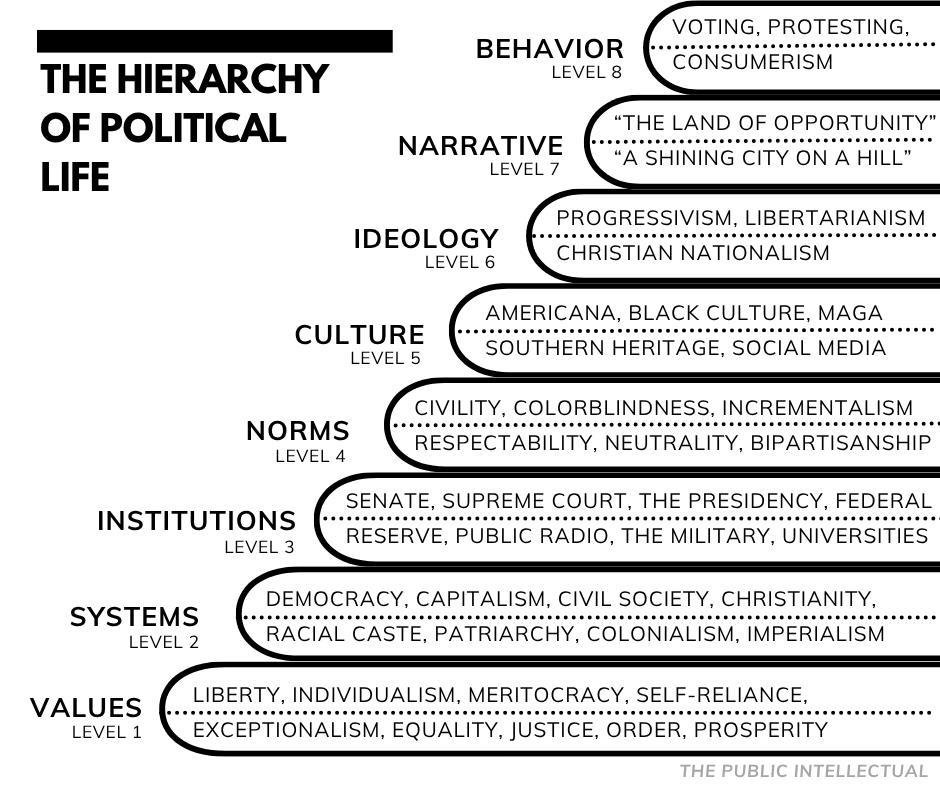I Built a Framework to Explain Our Politics. It Changed How I See Everything.
I stopped reacting and started mapping.
The progressive energy on social media gives me hope. It feels like an odd thing to even type, but it’s true. All of these bright young people with their thoughtful, fluid analysis and sharply executed political protests make me think, this is good… this is really good.
What’s missing from my feed, however, is sense-making — an understanding of how these political incidents roll up to the bigger political picture.
So, I made a thing. Mostly to guide my own understanding, but I’m not gonna lie… when I finished, I thought, damn, that looks good.
The Hierarchy of Political Life is a diagnostic framework that reveals the deep structure of the American political order. Think of how Maslow’s Hierarchy of Needs organizes human needs from survival to self-actualization. The Hierarchy of Political Life demonstrates how what we believe determines what we build, and what we build determines how we behave.
There are eight levels that flow from bottom to top:
Values
Systems
Institutions
Norms
Culture
Ideology
Narrative
Behavior
1. Values are the moral assumptions, cultural beliefs, and shared convictions about what is good, right, and desirable.
Examples: Individualism, Liberty, Meritocracy, Self-Reliance.
2. Systems are the organizing logics that operationalize values into social and political arrangements.
Examples: Capitalism, Democracy, Civil Society, Christianity.
3. Institutions are the formal bodies that enact and sustain those systems through governance and policy.
Examples: Congress, Federal Reserve, Supreme Court, Higher Education.
4. Norms are the unwritten rules and expectations that guide how people and institutions behave within the system.
Examples: Civility, Professionalism, Incrementalism, Colorblindness.
5. Culture is the collective habits, symbols, and expressions that emerge from shared norms.
Examples: Americana, Black Culture, Southern Heritage, MAGA.
6. Ideologies are the worldviews that bind values, systems, and culture into a coherent moral order, providing justification and meaning for the existing arrangement of power.
Examples: Progressivism, Libertarianism, White Nationalism, Conservatism.
7. Narrative refers to the meta-stories a society tells itself about who it is, how it came to be, and what it stands for.
Examples: “The Land of Opportunity,” “The American Dream,” “We the People.”
8. Behavior includes the visible actions, policies, and performances that result from all the layers beneath.
Examples: Voting, Protesting, Legislating, Consumerism, Political Speech, Political Violence.
Each layer influences the next. While causation mostly flows from the bottom to the top, there are feedback loops throughout that allow the higher levels (for example, political behavior and narrative) to influence the lower ones (institutions and norms). Together, they form the moral and structural ecosystem of our political reality.
Understanding the hierarchy changes the way we interpret the moment. When something happens, it no longer just gets logged under “political dysfunction” or “societal collapse.” We can locate it within this structure. By being able to assign, label, and categorize, we’re better able to diagnose and develop targeted responses when we experience disease in our body politic.
Instead of saying, “look at this bad actor,” we can ask, “what layer of the system is this activating?”
A norm being violated signals the destabilization of institutional power. A fracture in culture tells us that shared narratives are unraveling. Each level reveals something distinct about how power is moving.
And when we can see that clearly, we can respond strategically, not just emotionally.
Right now, The Hierarchy of Political Life is an intellectual exercise. I plan to test it out on Instagram and YouTube by using the framework to unpack and deconstruct the political zeitgeist. I haven’t launched the YouTube channel yet, but you can follow me on Instagram to join the conversation.
Let me know if you “get it,” or if you have feedback on the structure or flow.
I love building in community. It feels good.
…
Thanks for joining me on the journey as I prepare to launch my first book Union: How Caste Holds Democracy Together, While Threatening to Tear America Apart.
Coming Spring 2026.


